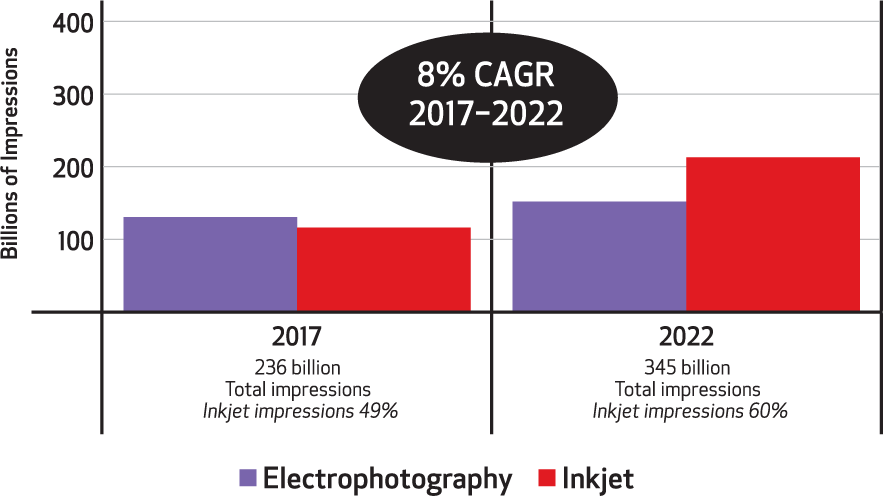Become the Master of Inkjet Applications
Although a common talking point in the print industry is that print is declining, printers should be moving toward some of the bright spots. One of those shining stars is inkjet and the applications that inkjet devices support.
Digital Print Volume Continues to Grow
Sources: U.S. Print on Demand Market Forecast: 2017–2022, InfoTrends, 2018.
Keypoint Intelligence—InfoTrends’ data indicates that digital production color volumes totaled about 236 billion impressions in 2017 and will approach 345 billion by 2022. Inkjet will account for 60 percent of total digital color volume by 2022, representing the new opportunities for growth. A number of factors are attributable to the growth inkjet enjoys, including technological innovations, cost-effective options for migrating offset jobs to digital color, the drive for more customized communications, and the introduction of completely new applications.
If you have (or are considering) inkjet presses, focus on applications. InfoTrends’ 2018 survey entitled High-Speed Inkjet Printing in Commercial Print Markets captured perspectives from current high-speed inkjet customers in key market segments of North America. This research also reached out to the next wave of prospective customers to identify their expectations. According to the inkjet users profiled, today’s prevalent applications for production inkjet include bills, statements, and regulated transactional communications for both roll-fed and cutsheet inkjet systems. At the same time, however, InfoTrends found that service providers are also using inkjet technology to produce marketing collateral, brochures, direct mail, “magalogs” (catalogs with article content), catalogs, books, magazines, newspapers, and packaging.
For 2019, look at these top applications to make the most of your investment:
The core value of production inkjet technology is that it enables print applications that other technologies cannot produce…
- General commercial printing applications: Brochures, pamphlets, newsletters, and marketing collateral have moderate to high ink coverage requirements. Both the print quality and available range of substrates for high-speed inkjet is regularly expanding. In addition to being a cost-effective solution for newsletters and brochures, inkjet supports the production of posters, end-of-aisle/point-of-sale signage, flyers, and most other commercial work.
- Transactional printing applications: Bills and statements for telecommunications, financial services, insurance, credit cards, and other regulated communications are the original high-speed production inkjet application. For printers not necessarily focused on these markets or high-volume critical communications, inkjet provides an ROI for applications such as solicitation letters, claims support, inquiry follow-up, governmental communications, and loyalty communications. Inkjet enables white paper factory workflows, reducing the cost and time associated with preprinted shells, and also allows for the consolidation of volume from various jobs. Furthermore, its ability to produce full-color print with variable data enables more targeted communications.
- Direct mail: Direct mail marketing, postcards, and a wide range of mailed marketing collateral form the backbone of most campaigns, and these often pair with online, mobile, or mass media delivery. For printed communications, inkjet provides a cost-effective solution that is available across a growing number of substrate options. Today’s inkjet devices can produce vibrant hues, faithfully reproduce brand colors, and support photographic images. In addition, digital technology means that campaigns can be highly targeted, even if they are not personalized.
- New opportunities: Given the wide range of customer preferences and available applications, new opportunities from inkjet include short-run personalized books, catalogs, and magazines. Small batch packaging is another area worthy of investigation, especially for folding carton applications to support craft entrepreneurs. These expanded product offerings have benefited from high-speed inkjet technology, and commercial printers that made an inkjet investment should not disregard these offerings.
As you review your application mix, it’s important to consider how inkjet can build value for your customers. You must also understand how to streamline production and lower costs with high-speed inkjet system integration. The core value of production inkjet technology is that it enables print applications that other technologies cannot produce, such as affordable high-value personalization, shorter runs, and versioning. High-speed inkjet systems produce high volumes for transaction and direct mail not because they are cheaper than offset, but because they can do something that offset cannot do. High-speed inkjet is delivering value to marketers, enterprises, and service providers. It offers affordable digital color and associated improvements in operational costs, response rates, and time-to-market. Organizations that have not yet explored the inkjet opportunity need to act now if they hope to enjoy all its benefits!
Interested in learning more? Check out InfoTrends’ written report or white paper entitled “Inkjet Applications Matter! Opportunities & Trends in Production Inkjet” to see the breakdown of inkjet suitability as well as more data about the inkjet market today.
WATCH THE VIDEO



